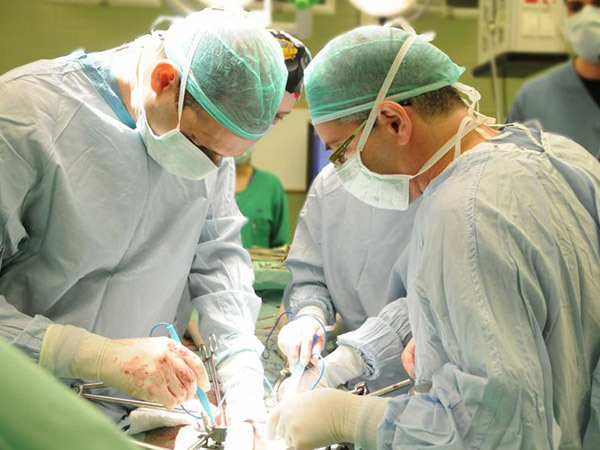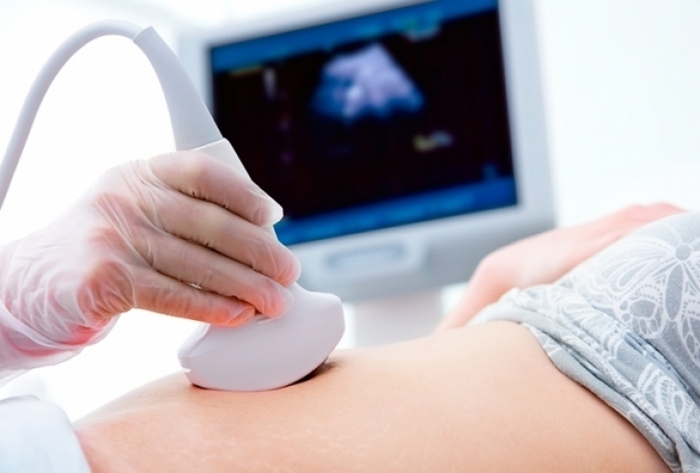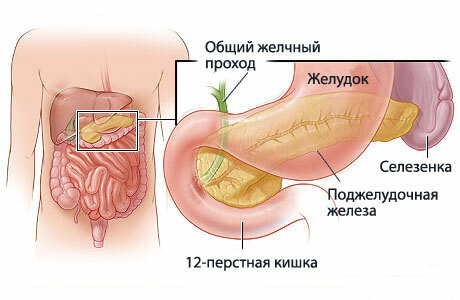Where is the pancreas located and how it hurts in a person: symptoms and on which side it is located
The whole human body consists of a mass of internal organs, among which the most important as an independent unit, and in particular, as a significant organ of the digestive process, is considered pancreas.
The functionality of this secretory organ, laid down by anatomy, often fails.
You need to understand where the pancreas hurts, because it is important not to miss the initial period of its disease and get medical help in a timely manner.
According to the anatomical location, the pancreas is located behind the stomach, along with the I-II vertebrae in the lumbar region.
It is securely attached by the connective tissue and the capsule to the back of the gastric walls. The duodenum supports the gland from its back.
The parameters of a normal gland for an adult are 20-25 cm, weight - 70-80 g.

Content:
- 1 The dependence of pain on the structure and functions of the pancreas
- 2 Symptoms of various pancreatic pathologies
- 3 Diagnostics
- 4 How is the pancreas treated?
- 5 How to know that it is the pancreas that gives pain
- 6 Types of pain in pancreatitis
- 7 When an ambulance needs help
- 8 Useful video
The dependence of pain on the structure and functions of the pancreas
It is necessary for oneself to determine exactly where the pancreas is located and how it hurts in order to understand the origin of the pains that appear.
The structure of the gland contains: head, body, tail. By location, the head touches the bile ducts, the body is attached to the back of the stomach wall, above navel by 5-10 cm, it is covered by the transverse colon, the tail stretches to the spleen, under the left edge.
The small gland has a naturally important functional effect - exocrine and endocrine.
Exocrine function is the synthesis of pancreatic fluid, aimed at normal digestion, which is provided by the duodenum.
Pancreatic juices contain enzymes:
- trypsin and chymotrypsin - digest protein foods;
- lactase and amylase - break down carbohydrates;
- lipase - breaks down fats after bile processing.
Pancreatic enzymes solve another problem - to neutralize the acidity of gastric juice in order to protect the intestinal mucous tissues from the influence of acids.
Endocrine function is the synthesis of insulin and glucagon, which are involved in carbohydrate hormonal processes.
It should be noted that only the pancreas synthesizes the insulin required by the body. Under its influence, the glucose content in the blood decreases, and under the influence of glucagon its increase occurs.
Soreness in different parts of the abdomen arises from indigestion.
It is important for yourself to understand where the pancreas hurts, when the pain is due to inflammation in iron, then you should timely go to an appointment with a local therapist to take the appropriate medical measures.
Symptoms of various pancreatic pathologies
In accordance with the low synthesis of pancreatic enzymes, external symptoms appear. The most likely manifestations are indigestion and associated pain.
The symptoms are the same in people of both sexes. How acutely the intensity of pain is manifested is a sign of pronounced manifestations of dyspepsia.
The most common symptoms of pancreatic dysfunction:
- pain is given to the upper part of the peritoneum, under the left rib;
- pain occurs regardless of food;
- there is nausea with bouts of vomiting;
- taste sensations are disturbed, appetite disappears;
- the stomach swells and growls;
- diarrhea appears; there are particles of undigested foods in the feces, especially fatty ones;
- general indicators of intoxication appear;
- the liver increases in size;
- changes in skin color, yellowness appears, often on the skin over the location of the pancreas.
How does the human pancreas hurt? Painful sensations are expressed in different forms - they are pulling, dull, cutting.
Their expression is associated with damage to the gland, with the spread of inflammation to the tissue of the peritoneum.
These symptoms characterize how the pancreas hurts in a person, and experts come to the conclusion about an exacerbation of pancreatitis.
The location of the foci of pain is due to where the human pancreas is located.
As a rule, unexpected sharp pains appear in this place, radiating along the upper abdomen.
If inflammation of the pancreas is accompanied by its swelling, a feeling of pressure from the inside on the ribs appears from the left side under the ribs.
At the same time, antispasmodic drugs do not help, the person himself softens the pain when he sits and bends down a little.
The pain is accompanied by repeated vomiting, but it does not bring relief. Vomit with an empty stomach is mucus with bile, leaves a bitter taste in a person's mouth.
Diagnostics
Similar symptoms are present in other diseases, therefore, differential diagnosis is important, which confirms or refutes the disease.
If pancreatic inflammation is suspected, an additional examination is carried out, and only with its results the gastroenterologist will be able to choose targeted therapy.
In terms of diagnostics, the following are carried out:
- laboratory blood tests to determine if it contains enzymes, glucose, whether bilirubin is normal;
- urine analysis to determine the presence of amylase;
- analysis of feces to determine the presence of food debris and fatty components;
- Ultrasound, which determines the structure, contours, the presence of calculi in the gallbladder and its ducts;
- radiography solves the same goals;
- CT or MRI, which provide accurate information about the state of internal organs.
A thorough examination shows how correctly the pancreas is located, whether there is a displacement, whether there is an increase in the parameters, swelling.
With an exacerbation of pancreatitis, patients require hospitalization.
How is the pancreas treated?
In stationary conditions, the patient is at rest, full bed rest is required. For the first two days, the patient needs complete fasting.
Food is carried out by drip injection of saline with drugs and nutrients.
Injections of anesthetic, antispasmodics are administered, if required by the patient's condition. Usually these are Baralgin, Platyphyllin, anticholinergics. Ice is applied to the epigastric zone 2-3 times a day for ½ hour.
What medications will be used for therapy during an exacerbation will be decided by the specialist of the department.
Intravenous droppers are placed, through which the patient receives funds that reduce the activity of enzyme synthesis, which is achieved by Trasilol, Kontrikal, Gordox, Aprotinin.
To avoid dehydration, droppers with salt formulations are placed. When an acute condition is relieved with the help of droppers and injections, the patient is allowed to eat a little on a sparing diet.
At the same time, doctors prescribe therapy with replacement enzymes to improve digestion - Creon, Panzinorm, Festal, Enzistal.
In the nutrition of the first days, when the exacerbation subsides, broths of a weak type, hated, the same decoctions from vegetables, mashed porridge in water, are allowed.
The food is cooked boiled, steamed, like mashed potatoes, soufflé. Strict adherence to the diet, along with drug treatment, is given the most important place.
The menu is replenished with fermented milk products, dried fruit compotes, jelly. A strict diet should be followed for 3 months.
Even if a period of remission comes, the diet should still be followed. According to the pain, the patient already determines where the pancreas is located, and corrects his condition by facilitating nutrition, adding enzymes prescribed by doctors.
How to know that it is the pancreas that gives pain
Painful symptoms show on which side the pancreas is located, and an experienced doctor will not be mistaken in determining the cause of the disease.
With the help of ultrasound, pathologies in the size, shape, density of the tissues of the gland are detected. These are common indicators for various pancreatic diseases.
Pancreatitis bothers many people, and they must be able to determine what pain is caused by the pancreas, because it is characterized by a special soreness.
Pain is defined in the left side, often in the middle of the abdomen. This often happens after a hearty meal, when the gland does not have time to produce the necessary enzymes for the proper digestion process.
Often people take Pancreatin themselves, and feel relief in the place from which side of the pancreas is giving painful signals.
This will bring temporary relief of pain, but with the help of Pancreatin, the person will feel where his pancreas hurts.
This moment is important for assessing your well-being in subsequent bouts of pain. And they will be, if the person does not turn to the local therapist in time.
The next attacks of exacerbation will be brighter, with a strong pain expression. They will show the person exactly where the pancreas is located.
Indigestion with vomiting, severe girdle pains indicate another exacerbation of inflammation of the pancreas.
The oblong shape of the gland causes pain in various zones of the peritoneum.
The location of the pancreas behind the stomach causes severe pain in all abdominal abductions.
If the exacerbation begins in the head, the pain is localized on the right side, which is similar to inflammation of the liver.
Aggravation in other parts of the gland is expressed by pressing pains that go under the left rib.
An exacerbation of a strong character is manifested by girdle pains, when it is generally not clear where the pancreas is located, from where the painful signal is coming from.
How to determine where the pancreas is located and how it hurts? Suddenly it comes down to specifically her inflammation.
Pain that radiates under the ribs, aching, sharp - this is already a weighty reason for going to an appointment with a local therapist.
Only based on the results of a detailed examination, the doctor will establish the nature of the pathology, choose an effective direction of treatment.
Types of pain in pancreatitis
Where the human pancreas is located is determined by the anatomy. This is practically the middle of the retroperitoneum, close to the back.
But her tail still stretches to the left side, to the hypochondria. The localization of pain in pancreatitis depends on such a peculiar location.
The features of the pain that the gland gives during attacks depend on its structure, because it is not hollow, but filled with glandular tissue.
The acute form of the disease is expressed by a severe pain attack in the upper abdomen. These are severe pains of an acute type, cutting, piercing, spastic.
Sometimes they are simply intolerable, and it is difficult for a person to wait for an ambulance to arrive.
The moment when an acute disease turns into its chronic form is characterized by the localization of pain under the left rib, spreading along the back.
No matter where and where the location of this important organ - the pancreas, is, it always gives painful soreness, intolerable.
Soreness is aggressive, comparable to painful sensations in acute inflammation, but differ in aching character, attacks of spasms, periodic manifestation of burning sensation in the epigastric region.
Chronic inflammation of the pancreas spreads excruciating pain to the back, left side of the body, because the gland is located next to the vertebrae.
Then the pain is called girdle, but always stronger in the back. It is difficult to cope with them, since they are caused by inflammation of the entire body of the gland, and it is necessary to remove pathological inflammation in the gland itself.
The causes of pain during inflammation of the pancreas are not only its inflammation, but also a change in anatomy:
- swelling of the gland and adjacent tissues;
- stretching of the capsule membranes;
- partial necrosis;
- damage to the tissues of the peritoneum by peritonitis.
Since the gland is located almost in the center, it seems that a knife is thrust into the middle parts of the chest cavity, penetrating through a person.
Then a person cannot show exactly where the pains are concentrated. It can be all parts of the abdomen, lower ribs, which is associated with the length of the gland under the stomach across the vertebrae, to the costal articulation.
With severe pains of the pancreas, the body lacks natural protection by muscle tension, since the gland is located far from the main structures of the peritoneum.
This point also helps the doctor establish the primary diagnosis. The pain is constantly and inexorably increasing, regardless of the meal.
With pronounced dyspeptic symptoms, repeated vomiting, upset stools, neither vomiting nor diarrhea bring relief.
They come later than all symptoms, since the digestive system takes a certain time to develop.
These are also important indicators of pancreatic disease. Vomiting is associated with irritability of the vagus nerves that innervate the pancreas.
With different manifestations of pancreatic disease, the intensity of vomiting is expressed in different ways, it can be with insignificant discharge, or watery and abundant.
Such vomiting leads to rapid dehydration of the body, so doctors are in a hurry to arrange the patient in the ward and begin drip infusions of nutrient fluid.
The patient's external behavior is restless - he cannot lie still, rushes about, constantly changes position, rolls, all the time holds his hands to his stomach.
With such active anxiety, it is accompanied by nervousness, increased excitability.
The skin turns pale, becomes covered with sticky sweat, collapse, characteristic of total organ damage, may occur.
When an ambulance needs help
If there is an acute pain attack, you need to call an ambulance. The doctors have not yet arrived, the sick person must hold out without taking painkillers, which can blur the picture of the disease.
You need to hold on even if the pain becomes unbearable. A change in posture can relieve the condition.
Doctors recommend kneeling and elbowing to relieve gland pressure on the solar plexus.
Acute pains will show a person on which side the pancreas is located.
Ice can be applied to this place on the stomach, it significantly reduces the activity of the organ.
Before the arrival of doctors, it is necessary to restrict movement; it is best to help a person to be immobile.
With such an attack, a sick person is recommended to be hospitalized, where emergency diagnostic measures will be taken and the question of the direction of treatment will be resolved.
Sometimes an exacerbation ends with an operation to remove the organ.



